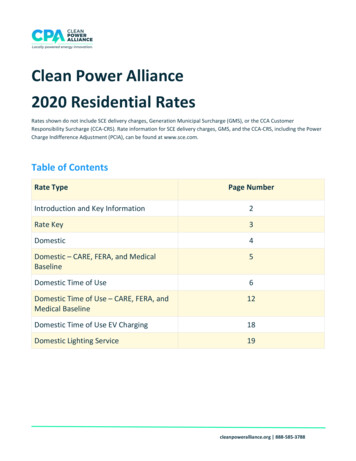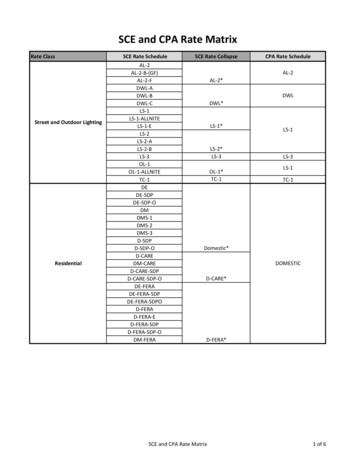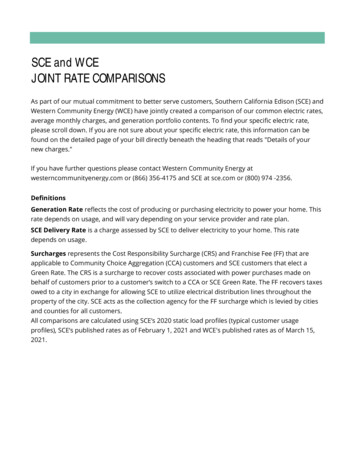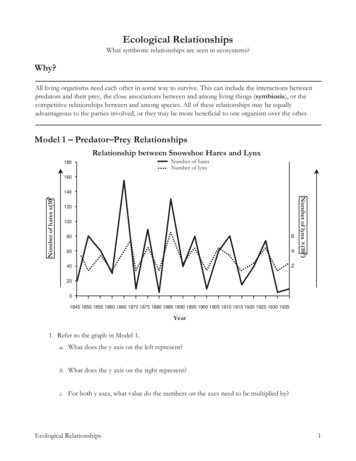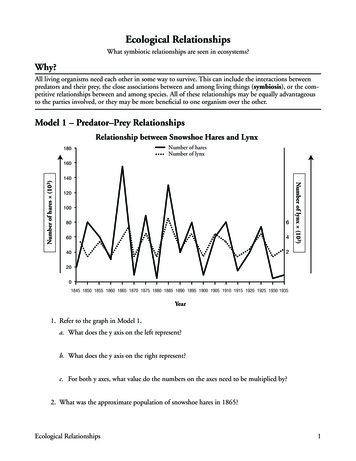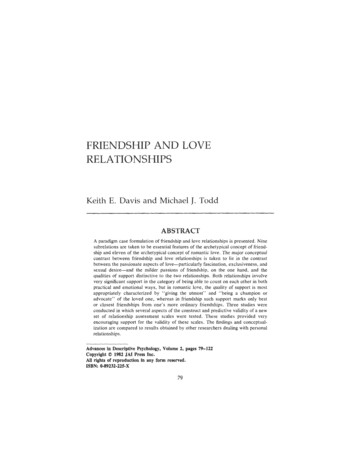
Transcription
FRIENDSHIP AND LOVERELATIONSHIPSKeith E. Davis and Michael J. ToddABSTRACTA paradigm case formulation of friendship and love relationships is presented. Ninesubrelations are taken to be essential features of the archetypical concept of friendship and eleven of the archetypical concept of romantic love. The major conceptualcontrast between friendship and love relationships is taken to lie in the contrastbetween the passionate aspects of love-particularly fascination, exclusiveness, andsexual desire-and the milder passions of friendship, on the one hand, and thequalities of support distinctive to the two relationships. Both relationships involvevery significant support in the category of being able to count on each other in bothpractical and emotional ways, but in romantic love, the quality of support is mostappropriately characterized by "giving the utmost" and "being a champion oradvocate" of the loved one, whereas in friendship such support marks only bestor closest friendships from one's more ordinary friendships. Three studies wereconducted in which several aspects of the construct and predictive validity of a newset of relationship assessment scales were tested. These studies provided veryencouraging support for the validity of these scales. The findings and conceptualization are compared to results obtained by other researchers dealing with personalrelationships.Advances In Descriptive Psychology, Volume 2, pages 79-122Copyright 1982 JAI Press Inc.All rights of reproduction in any form reserved.ISBN: 0-89232-225-X79
80KEITH E. DAVIS and MICHAELJ. TODDIn this essay our aim is to contribute to the scientific understanding ofpersonal relationships by taking two fundamental personal relationships-friendship and love-as central instances and by developing aconceptualization of each, and assessment procedures for research oneach. The conceptual resources that we will bring to bear are thoseavailable within Descriptive Psychology (Ossorio, 1966, 1969/1978, 1972/1978, 1981a, 1981c, 1981d) and his associates (Davis, 1981). In particular,we shall make use of the relationship formula, the notion of status dynamics, paradigm case formulations, and other conceptual devices toclarify the concepts of love and friendship as personal relationships. Ourwork builds on previous work, both published and unpublished, in Descriptive Psychology, including the unpublished work by Davis (NoteI) and by Marshall (Note 2), the published studies by Kelling (1972,1979), and Roberts (1981).The study of personal relationship has a long tradition in the socialsciences, and we will deal briefly with some of the major alternativepoints of view. But, because our primary objective is the presentationof an original system and its associated research procedure, we do notpretend to make a comprehensive survey of the approaches to the studyof relationships. Such a survey is in preparation by Davis (Note 3).DESCRIPTIVE PSYCHOLOGY AND THE STUDY OFPERSONAL RELATIONSHIPSFriendshipAn approach to the study of personal relationship grounded in Descriptive Psychology begins in the following way. We start with a paradigm case formulation (PCF) which is a genuine case of friendship(Ossorio, 1981d). While it is possible to have a friendship that does notinvolve mutual or reciprocal respect between the two persons involved,we have selected as our paradigm case one in which the subrelationshipslisted in Table 1 are mutual. Thus, the first person is taken to respecthis or her friend who returns the respect. The reason for this selectionof the paradigm is that mutual or reciprocal friendships are clearly genuine cases and ones which, furthermore, are archetypal. That is , theyconstitute the full case by virtue of which other cases are recognized asinstances of that king of thing. If no friendships involved reciprocal trust,respect, or confiding, then our concept of such personal relationshipswould be quite different from what they are. Following Ossorio's (198ld)rule of thumb that, in picking one's paradigm case, one wants not onlya genuine case but a complex one, we have in Table 1 gone in thedirection of picking a very elaborate case. Such elaboration allows us
Friendship and Love RelationshipsTable I.81Relationships for the Paradigm Cases of Friendship andLoveFriendshipEqual EligibilitiesEnjoyTrustMutual gIntimacyRomantic LoveAsymmetric EligibilitiesEnjoymentAdvocate/ChampionGive the imacyFascinationExclusivenessto represent simpler cases by deletion or removing restrictions on individual cases.It is useful to note some variety among cases that count as paradigmcases. In the first instance, any genuine case may be used as the paradigmcase. But, it is often heuristic to have the paradigm case also be afundamental or archetypal case. Cases with such a status are those whichmore readily exemplify the essence of the case. Thus, in the case of theconcept of family, a wife, who has been widowed and who has two ofher children living at home, clearly counts as a family; however, sucha case would not count as one's fundamental case because the fatherwas not present. Fundamental or archetypal cases need not be statistically frequent cases. The case of husband, wife, and children living athome constituted only 18.5% of American families in 1976. But it countsas an archetypal case. A third type of paradigm case is that of the originalcase-the first discovered instance or the precedent-setting case (as ina legal context). We think of the paradigm cases of friendship and lovepresented in Table 1 as archetypal paradigm cases, but, we shall use"archetypal" and "paradigm" as alternative locutions to refer to thePCF provided in Table 1.As both Littmann (1983) and Roberts (1982) illustrate in this volume,paradigm case procedures can be used to generate the variety of instances, say, of humor or of personal relationships between men andwomen. The critical step in this procedure is that of selecting featuresof the paradigm case that are to be changed by some transformation.The most common transformations are deletion (i.e., removing a restriction of a particular sort) and a reflexive inclusion of some feature of theoriginal PCF within itself. To see how deletion works, let us start withour paradigm case of friendship . It is one in which the relationship is
82KEITH E. DAVIS and MICHAELJ. TODDreciprocal or mutual. But, one can easily remove this restriction and,thus generate cases, which obviously occur in the real world , in whichthe friendship is not mutual. Not only are there cases of unrequitedfriendship, but, even where the two persons may be said properly to befriends, one person may not respect a friend's judgment in financialmatters or in the selection of partners of the opposite sex and yet theymay still be friends. The lack of mutual respect marks it as a certaintype of friendship, but, it certainly qualifies as a friendship.A PCF provides a way of representing the structure of the subrelationships that are taken to be fundamental to clarifying how the relevantpersonal relationships operate. The subrelationships have been selectedbecause they constitute, in our judgment, the kinds of considerationsthat are relevant to explaining the ways in which the particular relationships exemplify the general category and the ways in which suchrelationships can be said to go wrong or to be defective. That one isintimate with another person in the sense of sharing personal goals,aspirations, and fears is a state of affairs that marks the developmentof a particular type of friendship-a close, personal one. The failure toshare anything other than what can be gained from first-hand observationmarks a different kind of friendship-a more reserved or formal one.The kind of claim that we make with respect to the items in Table 1 isnot that they provide a statement of necessary and sufficient conditionsfor the application of the concept of friendship to specific cases, butrather that they constitute a set of reminders of considerations relevantto cases counting as genuine instances. Or, alternatively, they constitutea set of categories in terms of which the case may be said to be genuine,but one which varies from the archetypal case in one or more selectedways. ("Mike and Joe are friends, but Joe always has to be top-dog."Such a case marks the fact that Joe's personal characteristics place alimit on his being as good a friend of Mike's as he might if he did nothave to be top-dog.)The paradigm case presented in Table 1 is an unconstrained casethat is, the realization of the friendship or love relationship is not limitedby the reality of individual differences nor by those of social position.The introduction of these constraints automatically places limits on therealization of any specific personal relationship, and thus one encountersthe variety of real world cases of friendship none of which are exactlylike the archetypal paradigm case.Because the explicit use of paradigm case procedures is novel, thereare doubtless questions about the procedures that cannot be answeredin this context. Perhaps the most useful reminders about the procedureare: (a) That a PCF is not a definition, that is, it is not a statement ofnecessary and sufficient conditions for the use of a label; (b) that a PCF
Friendship and Love Relationships83presupposes a person who is using it and who has the ordinary competences involved in recognizing instances and in reasoning about them;and (d) that alternative PCFs of the same concept are possible becauseof legitimate differences in purposes and focus. Indeed the PCFs offeredby Roberts 1982) and us are not identical, although they share a commoncore of subrelationships. The issue of how PCFs of the same conceptcould differ and yet be acceptable for scientific work will be dealt within the introduction to Part I of this volume. (See also Ossorio [1981d]and Bambrough [1961].)The following are features of the paradigm case formulation for friendship which is taken to be a relationship in which the two persons , whoare friends:1. Participate as equals in the sense that those things that one personis eligible to do the other is also eligible to do. (Equal Eligibilities)2. Enjoy each other's company. Such enjoyment needs to be understood as a dispositional characteristic of the relationship. It is not,therefore, incompatible with states of mutual annoyance, anger, ordisappointment. But , if enjoyment were not the norm, it wouldmake the explanation of continued association difficult. (Enjoyment)3. Have a relationship of mutual trust in the sense that each takes itthat the other person will act in light of his friend 's best interest.(Trust)4. Are inclined to provide each other with assistance and support(Telford, 1971) and, specifically, assume that they can count oneach other in times of need, trouble, or personal distress. (Mutual.Assistance)5. Accept each other as they are, without being inclined to change ormake the other over into a new, different person. (Acceptance)6. Respect each other in the sense of taking it that each exercisesgood judgment in his or her life choices. (Respect)7. Feel free to be themselves in their relationship, rather than feelingrequired to play a role , wear a mask, or inhibit expressions of theirpersonal characteristics. (Spontaneity)8. Have come to understand each other, not merely in the sense ofknowing facts about each other, but in the more fundamental senseof understanding the rationale of the other' s behavior. In such cases,one person is not routinely puzzled or mystified by his or herfriend's behavior. (Understanding)9. Are intimate in the sense of sharing experiences by virtue of doingthings together and, in many cases, by virtue of confiding in eachother. The intimacy may extend to physical intimacy , but it neednot take such forms to count as intimacy. (Intimacy)
84KEITH E. DAVIS and MICHAELJ. TODDThe archetypal paradigm case of friendship makes it clear immediatelywhy such a personal relationship would be valued, indeed exalted in lifeand literature. To be in such a relationship not only increases one'sbehavior potential, because one has a completely loyal ally, but alsoprovides a context in which to realize one's own personal growth. Tobe responsive to the bonds of friendship is, genuinely, to grow as aperson, or in a more old-fashioned phrase, to develop one's character.The importance of having and being a friend is widley recognized in theliterature on social development, psychopathology, and adult development, but it is not clear that any of these literatures have an explicitformulation of what the relationship is and, hence, of why friendshipought to be a valued state of affairs for a person. We believe that thisformulation does just such a job-making us appreciate why the idealof friendship has the status that it does in all cultures. But, as we allknow, real world friendships seldom achieve the exalted status of thoseidealized friendships celebrated in poetry and hortatory literature. Whynot?In Descriptive Psychology, we have a general principle that providesthe fundamental recourse for understanding the variation between thearchetypal paradigm case and everyday cases. The archetypal case isin unconstrained or unlimited personal relationship, and, in this sense,it is an idealized relationship. There are, logically, two major types ofconstraints on personal relationships; there are the personal characteristics or individual differences of the persons involved and the socialstanding or status that they have in the community. It is important tounderstand that the constraints introduced on personal relationships bothby the characteristics of the participants and by virtue of their positionin the system will necessarily limit the degree to which any specificrelationship involves, to the fullest extent possible, the features of thearchetypal case.A couple. of illustrations may be helpful here. In the case of personalcharacteristics, there is a long history of developmental theorizing andresearch which makes it quite obvious that, say, suspiciousness or aparanoid streak constitutes a personal characteristic that will fundamentally limit the degree to which a person having that characteristic canbecome a friend with someone else. And that particular personal characteristic has its effect on the relationship through limiting the degreeto which a person trusts anyone with whom he or she deals. Nothingthat the other person does can "prove" that the other person is trustworthy to the fundamentally and completely suspicious person. For theoption is always present that whatever the other person does, that personis merely trying to prove that he or she is trustworthy when in fact, thereal goal is some form of exploitation. Thus, while a truly suspicious
Friendship and Love Relationships85person may call some small number of others friends, his or her mannerof treating those others and the kind of choices made in relating to themwould certainly mark a relationship that differed significantly from thearchetypal case of friendship.One can see the same phenomena-friendships being limited by personal characteristics-in innumerable cases: alcoholism, drug addiction,competitiveness, moodiness, and so on. In each of these cases, whenone thinks of the implication of the personal characteristic and how itmight relate to the person's capacity to enter into and maintain a friendship one can see that there are indeed limits to such a person's abilityto be a friend.The same kind of thing holds with respect to positions in the community. Anyone who is promoted in an organization and thus has toexercise authority over former peers, some of whom may have beenfriends, becomes aware of limits on his or her ability to maintain thesefriendships. To the extent that someone in the organization is a closefriend, a superior is automatically liable to the judgment that any actiontaken with respect to that person is biased by the friendship. Since anyposition of authority is governed by the norm of impartiality or fairnessin the treatment of all subordinates, the full exercise of one's inclinationsas a friend places one at risk of conflict with the requirements of theoffice. We certainly do not mean to say that friendships between peoplewho are at different levels within a hierarchy are impossible. Quite thecontrary ; we expect to find many instances of such friendships. Thatpoint is that the constraints of their social positions will necessarily andproperly place some limits on the ability of these individuals to implementfully a friendship. In the case of the example just given, the personholding the position of authority must, of necessity , either place somelimits on assisting a friend within the organization, or run the risk ofbeing seen as indulging in cronyism or favoritism. The latter will certainlyaffect o-rganization morale and perhaps this person' s tenure in authority.When faced with these kinds of potential conflicts, individuals will makechoices , expressive of their own personal characteristics. A person valuing loyalty over appearance may favor friends and punish enemieswithin the organization. A person valuing fairness and impartiality aboveall may be evenhanded to the point of coldness in dealing with friendswithin the organization. Thus, it is a fundamental conceptual point inDescriptive Psychology that personal relationships are constrained intheir realization by the personal characteristics of the participants andby the statuses that they hold within the community. Because the individuals involved in personal relationships are persons and have freedomof choice, the exact ways in which these general constraints will beexpressed in specific relationships is an empirical matter.
86KEITH E. DAVIS and MICHAELJ. TODDA major implication of the principles discussed above is that, in thevariety of real world relationships that count as friendships, one will findrelationships which, to varying degrees, will be deficient with respectto the qualities listed in the paradigm case of friendship. In some instances, the friendships will be one-sided. For example, one member ofthe friendship may treat the other person as a genuine and perhaps closefriend, but, the second person may treat the first person more like asocial acquaintance. This different understanding of the relationship canbe detected by assessment procedures that will be described later in thepaper.Another major type of variation in relationships that will still legitimately count as friendships are in the degree to which one or both ofthe partners may, for example, respect each other. Some ground floor,some minimal level, or threshold value of respect seems essential to callthe relationship a friendship at ali-in contrast to, say, a mutually exploitive relationship or a relationship of convenience. But friendships doclearly exist in which the other person cannot be counted on to exercisegood judgment. For example, we may think that, while our friend Joeis a great guy, he is a fool in his choice of women. If he is indeed afriend, one does not walk away from him because he has bad judgmentin his choice of women, although one might arrange not to spend timewith him when he is in the company of his poor choices. The friendshipone would have with Joe is constrained by his poor judgment in thatarea and, in this example, the effect of that is to provide Joe's friendwith a reason not to associate with him when he is out with women.Likewise, specific friendships may be deficit in any of the nine subrelationships identified in Table I, but still remain genuine friendships.But, this state of affairs raises the question of to what degree can onetreat a relationship as a friendship when it is deficient to a significantdegree in several subrelationships?Two reminders are important in this context. The first one followsfrom the famous philosophical dialogue on whether a specific game countsas an instance of chess. In that dialogue, the presupposition of the example is that the Queens have been removed and that no pieces areallowed to make the moves permissible to the Queen. The question thenis "Is it a game of chess or not?" And the outcome of the dialogue isthat one has good reasons for treating it as a game of chess and alsogood reasons for not so treating it. Whatever one calls the specific gamewould be misleading unless qualifications were stated. The same stateof affairs holds for social relationships that are "friendship-like." Forsome of these cases, we have existing descriptive phrases that embodythe qualifications: "They are drinking buddies" (but not really friends);"They are business friends" (but not intimate or personal friends); or
Friendship and Love Relationships87''They are untied by their common hatred of a third person'' (but whetherthey will be friends when he is gone is entirely open to doubt.) Theimplicit but usually unspoken qualification is in parentheses. For others,we have to make the qualification explicit if we do not wish to misleadour hearers.The second reminder is that, in the strict sense, the list of relationshipsthat characterize the paradigm case of friendship are not to be understoodas components, aspects, or building blocks out of which one can createthe fundamental relationship. The relationship is itself primary and thesubrelationships listed in Table I are a language for describing and clarifying ways in which instances of friendship may go wrong or be deficientwith respect to the paradigm case of friendship. A PCP starts with agenuine instance-not with components.In what sense is the PCF of friendship multidimensional?Because the paradigm case formulation of friendship (and of love)presented in Table 1 consists of a list of subrelationships, it is easy tothink that the model being proposed is a multidimensional model. Whileit is conceptually multidimensional, it would be misleading to assimilatethis to the standard statistical sense of multidimensionality in which thedimensionality is derived from multidimensional scaling or factor analyticprocedures. The multidimensionality at issue in our formulation is conceptual, and no presupposition is made that each of these dimensionswill be statistically independent of the others. Indeed, one would expectthat there would be a strongly positive intercorrelation among all of thedimensions associated with friendship in our Table 1. Then what is theforce of saying that this is a multidimensional model?The subrelationships identified in Table I are to be understood in thefollowing sense. They constitute a language that is available to membersof the community for making distinctions within and between relationships and particularly for noting in what respect and in what way aparticular relationship has gone wrong and in what way a desirable stateof affairs has been achieved. In this respect, friendship and love aresimilar to the concept of health-health being a notion which is difficultto identify by positive features but quite easily identified by deficits. Therelationship language (e.g., trust, respect), that we are applying in theparadigm case formulations serve, in many cases, as disguised doublenegatives. For example, to say that Tom and Mary are friends but thattheir relationship is characterized by a lack of trust in the area of theopposite sex, is to say that their relationship lacks something that, inthe paradigm case, it would have. And as we have commented earlier,if the deficit of the subrelationship is severe enough, it may call intoquestion whether or not we should treat the relationship as a friendship
88KEITH E. DAVIS and MICHAELJ. TODDor love relationship at all. Clarification is a different task from analysis,particularly if analysis is understood to involve the breaking of a largerwhole down into its component units; Trust, Respect and the other itemslisted in Table 1 are not components or elements. Despite the fact thatwe can independently identify trust in relationships and respect in relationships outside of the context of a friendship, in the context of thesocial reality of friendship, these dimensions are our means of categorizing how the normal, "healthy" relationship can succeed or fail.Romantic Love RelationshipsIn the last decade, the study of romantic love and other intimateheterosexual relationships has come into its own within social psychology. A number of social psychologists and other behavioral scientistshave made serious and sustained attempts to conceptualize the generaldomain of personal relationships or specific domains such as love orfriendship. Among the more notable general conceptualizations havebeen those by Hinde (1979), Kelley (1979), and Levinger (1974, 1979).Among those who have devoted substantial attention to romantic loveare Hatfield, Utne, and Traupmann (1979), Lee (1973, 1977), Murstein(1976, 1980), Rubin (1970, 1973), Schwartz and Merten (1980), and Walster and Walster (1978). In the area of friendship, the major theoreticalformulations and associated research efforts have been made by Kurth(1970), La Gaipa (1977b, 1979) and Wright (1969, 1973). The growingwork in this area has also been reviewed and systematized by Cook andWilson (1979), Dickens and Perlman (1981), and Huston and Levinger(1978).The paradigm case of romantic love embodied in Table 1 differs fromfriendship relationship in a number of important respects and yet sharessome very important similarities. To highlight the areas of difference,we might begin with the first item of the Table, which is the notion ofasymmetric eligibility or asymmetric status. Because a paradigm caseof romantic love is a case involving members of the opposite sex, theindividuals involved typically have different eligibilities. That is, onetype of behavior on the part of a man will count differently than thatsame behavior would on the part of a woman. One of the most fundamental eligibility differences is associated with the structure of the maleand female sexual anatomy . Wolgast (1980) argues that a range of predictable but not universal differences in how specific behaviors arecounted in most societies follow from this anatomically rooted behavioraldifference.Just as the eligibilities of men and women lead us to count or interpretthe same behaviors differently even in romantic relationships, there are,
Friendship and Love Relationships89likewise, similarities in eligibility. To be loved by the one who loves youcounts as an affirmation of one's masculinity or femininity. (See Roberts,this volume, & Wolgast, [1980] for an extended treatment of "man" and"woman" as status concepts.)Not every behavior of an individual in a romantic relationship is affected by sex-role eligibilities, but many are. It appears that no humansociety has failed to have some kind of double standard for men andwomen. Gender differences have been one of the community's fundamental status distinctions, but exactly which behaviors are treated asbeing appropriate to men or to women have varied enormously fromsociety to society (e.g., Mead, 1935). To deal adequately with the question of change in the content gender identities would take us too farafield in this apper, but see the paper by Bernard (1981) on the topic.The "double standard" at the heart of sex-role differences provides someof the most apt illustrations of this point.Some of the other important differences between romantic love andfriendship may be seen in the contrast between Trust and Advocacy.The notion of Advocacy involves furthering or Championing another'sinterest. To champion another person marks that person as a specialfriend.The notion of Giving One's Utmost to the lover when he or she is inneed is deeply rooted in Western romantic folk tales. Both men andwomen lovers are eligible to do this-witness Heloise in the tale ofAbelard and Heloise. A friend, however, is not expected to make suchsacrifices, unless, perhaps, he or she is a best friend.Of course, the most obvious difference between a romantic love relationship and a friendship lies in a cluster of subrelationships whichcollectively might be identified as the Passion cluster-Fascination, Exclusiveness and Enjoyment. Fascination can be seen as central to romantic love and deserves particular elaboration.To be fascinated with another person is to be inclined to pay attentionto that person even when one should be engaged in other activities.Fascination is thus a state that carries with it strong expectations aboutbehavior, but it also involves appraisal or evaluation of the other person.The things or persons that fascinate one are those which one treats asworthy of attention, and while one may be fascinated with evil or witha perfectly horrible person, the positive fascination of love is equivalentto the appraisal of the person as worthy of one's attention to the exclusionof almost any other concern. Logically, fascinations are part of a sequence of states ranging in intensity from interest, to fascinations, topreoccupations, to obsessions (Ossorio, Note 4; White, 1964). When oneis fascinated by another person, that person typically occupies one'sthoughts; one wants to be with that person, wants to see him or her,
90KEITH E. DAVIS and MICHAELJ. TODDtouch him or her, wants to be close to him or her, and one would beupset and disturbed if one were forced to be separated from him or her.A frustration of this fascination, which can occur because the fascinationis not reciprocated by the other person or because the other person isunaware of the interest with which he or she is viewed, can intensifythe state of fascination. In this respect fascination shares the logic ofother emotional behaviors. If one cannot act on the impulse generatedby the relevant appraisal, that is a causal condition for "feeling" theemotional s
ships-friendship and love-as central instances and by developing a . which obviously occur in the real world, in which the friendship is not mutual. Not only are there cases of unrequited friendship, but, even where the two persons may be said properly to be friends, one pe
